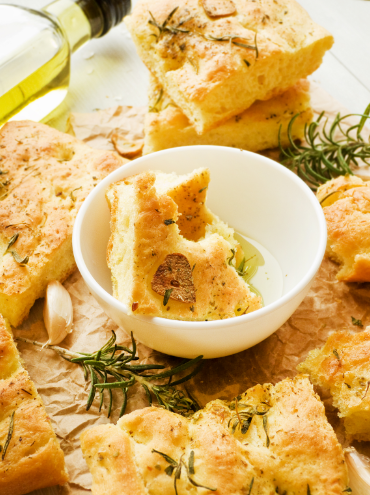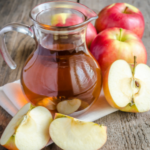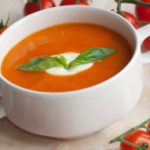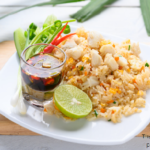Biaggi’s Focaccia bread recipe is a wonderful Italian delicacy fashioned from basic yet savory ingredients. This flavorful bread’s dough is soft, airy, and just a little chewy thanks to a combination of premium olive oil, fragrant rosemary, sea salt, and fine flour. The word “focaccia,” which means hearth or fireplace in Italian, comes from the Latin word “focus,” where this rustic bread was traditionally prepared. The outcome? A bread that dances between the deep, earthy flavors of olive oil and the herbaceous suggestion of rosemary in flavor, as well as having a golden, crunchy exterior.
Why You’ll Adore Biaggi’s Focaccia Bread Recipe
- The Traditional Italian Heritage: The Traditional Italian Heritage is embodied in the Biaggi’s Focaccia Bread Recipe. It is a culinary masterpiece that honors Italy’s rich culinary tradition. It is made with a harmonious combination of quality olive oil, fragrant rosemary, sea salt, and fine flour.
- Mesmerizing Texture: Biaggi’s Focaccia is distinguished by its exquisite texture. The bread is soft and airy with just the right amount of chewiness thanks to the dough’s addition of delectable olive oil.
- The Allure of Golden Crust: The golden, inviting crust of Biaggi’s focaccia bread entices you to indulge. This crust offers a doorway to the delicious tastes inside, not simply the top layer.
Biaggi’s Focaccia Bread Recipe Ingredients
- 4 cups of fine flour form the base, lending a tender yet chewy texture.
- 1 ½ cups of warm water activates the yeast, facilitating a fluffy rise.
- 2 ¼ teaspoons of active dry yeast works its magic as the primary leavening agent.
- 1/2 cup of olive oil imparts richness, moisture, and that unmistakable Mediterranean flavor.
- 2 teaspoons of granulated sugar nourish the yeast and add a subtle sweetness.
- 2 teaspoons of sea salt regulate yeast activity and enhance the bread’s flavor.
- 2 tablespoons of fresh rosemary leaves infuse the dough with fragrant, pine-like notes.
- Additional olive oil, for drizzling before baking, adds a glossy finish and intensified flavor.
How To Make Biaggi’s Focaccia Bread Recipe
- Activate the yeast first. Sprinkle the yeast over the sugar when it has dissolved in the heated water. Allow it to sit for 10 minutes or until it foams.
- Combine the fine flour and sea salt in a big bowl. Pour the olive oil and yeast mixture in gradually. Mix until dough starts to form.
- On a floured surface, knead the dough for 5 to 7 minutes, or until it is smooth and elastic. It should double in size after about an hour of rising in an oiled bowl with a lid on it.
- Turn on the oven to 425 °F (220 °C). Press the risen dough onto a greased baking sheet, making dimples with your fingertips.
- Sprinkle fresh rosemary leaves and olive oil over the dough. Bake for 20 to 25 minutes, or until aromatic and golden brown.
- Before cutting, let the focaccia cool slightly. This bread is ideal for enjoying and sharing with loved ones.
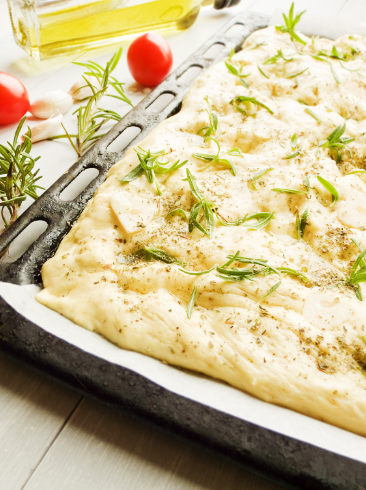
Recipe Variations
- Focaccia with Sun-Dried Tomatoes and Fresh Basil: Sun-Dried Tomatoes and Fresh Basil turn Biaggi’s Focaccia Bread into a Mediterranean masterpiece. Finely chop the sun-dried tomatoes and distribute them together with the fresh basil leaves on the dough.
- Focaccia with garlic and parmesan: Add a savory touch to improve your experience with focaccia. Sprinkle grated Parmesan cheese and minced garlic liberally on top of the dough before baking. The end result is a bread with an appealing blend of the sharpness of garlic and the creamy saltiness of Parmesan. It also has a delectable, golden crust.
- Kalamata Olive & Rosemary Focaccia: Infuse the dough with the flavor of the Mediterranean by including pitted Kalamata olives and rosemary. The rosemary lends its distinctive herbal scent, and the olives offer a saline depth.
- Focaccia with Roasted Garlic and Rosemary: Incorporate roasted garlic and rosemary into the dough to enjoy their potent smells. Roast whole garlic cloves until they are tender and sweet, then combine them with rosemary before adding them to the dough.
What To Pair With Biaggi’s Focaccia Bread Recipe
- Mushroom Risotto: Enjoy Biaggi’s Focaccia with the silky richness of the mushroom risotto. The creamy rice lends a sumptuous touch to your dinner, while the umami flavors of the mushrooms meld perfectly with the bread’s light sweetness.
- Minestrone Soup: This dish pairs well with a hearty minestrone soup that is bursting with beans and veggies. Focaccia’s crunchy crust and soft crumb contrast comfortingly with the soup’s powerful broth and chunky components, making for a filling, well-balanced supper.
- Grilled Shrimp Skewers: Serve your focaccia with grilled shrimp skewers for a seafood touch. The shrimp’s charred, smokey aromas go well with the Mediterranean flavor of the bread. For a zesty and aromatic improvement to your meal, add a squeeze of lemon and some fresh herbs.
How To Store This Recipe?
- In The Fridge: To preserve the texture and flavor of the newly baked Biaggi’s Focaccia, store it at room temperature in an airtight container or wrapped in plastic. To get the most out of it, eat it within two to three days.
- In The Freezer: Place the focaccia in a freezer-safe bag or container after carefully wrapping it in plastic wrap and making sure it is airtight. It has a three-month freeze-term. At room temperature, defrost it when you’re ready to use it.
- To Reheat: Set your oven to 350°F (175°C) before reheating. The focaccia should be heated fully, so place it on a baking sheet and warm it there for 5 to 10 minutes. This will bring back its delicious flavor and texture.
Frequently Asked Questions
How do you achieve the perfect airy texture in this focaccia recipe?
In order to get the appropriate airy texture in Biaggi’s Focaccia, the combination of ingredients and a skillfully conducted preparation are crucial. When properly kneaded, the fine flour ensures a healthy gluten structure, which adds to the bread’s airiness. The yeast and warm water combine to produce carbon dioxide gas when given enough time to ferment. This gas causes the dough to rise. Furthermore, delicate handling while kneading and proofing promotes the formation of air pockets in the bread, producing the desired light and airy crumb. The final factor that contributes to the golden crust is a heated oven and the initial high temperature. A drizzle of olive oil retains the desired crispness, providing the ideal contrast to the interior’s fluffiness.
Can I substitute all-purpose flour with whole wheat flour for a healthier option?
It is feasible to replace all-purpose flour with whole wheat flour, but the texture and flavor will change. Because whole wheat flour is coarser, it might produce a focaccia that is denser and heartier. Consider blending the two flours to improve the softness and rise. While all-purpose flour is necessary to balance whole wheat flour for a lighter, airier result, whole wheat flour provides a nutty flavor and health advantages. By gradually experimenting with the ratio, you can find the ideal balance that provides both the desired texture and nutrition.
What’s the secret to achieving a perfectly crisp, golden crust?
Temperature and moisture are the two keys to obtaining the wonderfully crisp, golden crust in Biaggi’s focaccia. Make sure the oven is sufficiently hot before baking by setting the temperature to a high level, about 425°F (220°C). The initial heat source promotes crust development quickly. A last trickle of olive oil improves the crispness of the crust by adding moisture and glossiness. Striking a balance is essential since too much moisture can result in the crust becoming soggy. Avoid packing too many toppings on the dough as this can hinder crust formation. You’ll perfect the skill of producing a delicious, golden exterior for your focaccia if you keep these things in mind.
Recipe Nutrition Facts
Calories: Approximately 200-250 calories per serving. Total Fat: Varies based on the amount of olive oil used. Carbohydrates: Around 35-40 grams per serving. Protein: About 5-7 grams per serving. Fiber: Approximately 2-3 grams per serving. Sugars: Varies, depending on the added ingredients. Sodium: Around 400-500 milligrams per serving. Vitamin A: Negligible. Vitamin C: Minimal. Calcium: Minimal. Iron: About 2-3% of the daily recommended intake per serving.
Try More Recipes:

Biaggi’s Focaccia Bread Recipe
Description
Biaggi’s Focaccia bread is a wonderful Italian delicacy fashioned from basic yet savory ingredients. This flavorful bread’s dough is soft, airy, and just a little chewy thanks to a combination of premium olive oil, fragrant rosemary, sea salt, and fine flour. The word “focaccia,” which means hearth or fireplace in Italian, comes from the Latin word “focus,” where this rustic bread was traditionally prepared.
Ingredients
Instructions
- Activate the yeast first. Sprinkle the yeast over the sugar when it has dissolved in the heated water. Allow it to sit for 10 minutes or until it foams.
- Combine the fine flour and sea salt in a big bowl. Pour the olive oil and yeast mixture in gradually. Mix until dough starts to form.
- On a floured surface, knead the dough for 5 to 7 minutes, or until it is smooth and elastic. It should double in size after about an hour of rising in an oiled bowl with a lid on it.
- Turn on the oven to 425 °F (220 °C). Press the risen dough onto a greased baking sheet, making dimples with your fingertips.
- Sprinkle fresh rosemary leaves and olive oil over the dough. Bake for 20 to 25 minutes, or until aromatic and golden brown.
- Before cutting, let the focaccia cool slightly. This bread is ideal for enjoying and sharing with loved ones.
Notes
- Developing Your Kneading Skills: To make Biaggi’s Focaccia, you must develop your kneading skills. When doing this, use a firm yet soft touch. Allow the dough to become elastic and smooth, a task accomplished with time and accuracy. The bread’s welcoming, airy texture is largely a result of this action.
- Effective Yeast Activation: Make sure the yeast activation phase is effective. Use water that is the appropriate temperature, ideally 110°F (43°C). Spread the yeast over the water, and then leave it alone until it begins to foam up wonderfully. The cornerstone of a flawlessly risen focaccia is this important step.
- Optimal Rising Time: It’s critical to master the science of dough rising. Place the dough in a warm, draft-free area to rest and rise. Ideally, wait until it doubles in size, which should take approximately an hour. The magic happens at this point, turning the dough into a light and airy treat.

